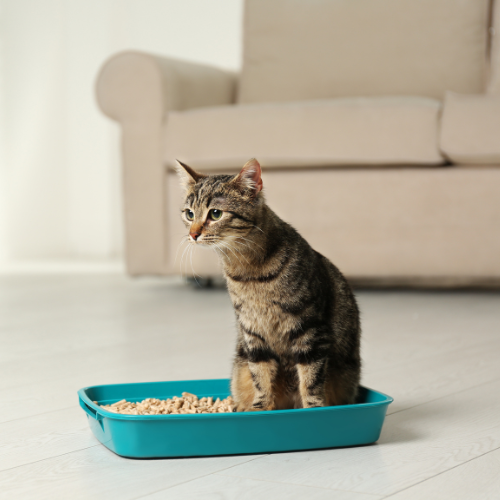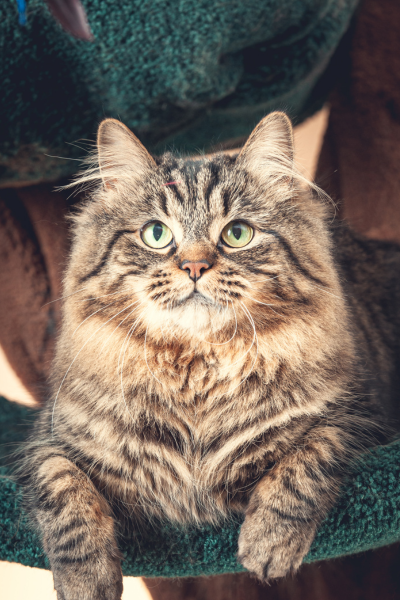Feline Lower Urinary Tract Disease (FLUTD)
What is feline lower urinary tract disease (FLUTD)?
Feline lower urinary tract disease (FLUTD) is an ‘umbrella term’ (rather than a specific disease) for a group of conditions that affect the bladder and urethra of cats.
What are the clinical signs of FLUTD?
Cats with FLUTD will often present with one or more of the following signs:
- Increase urination frequency (pollakiuria):
- Blood in the urine (haematuria)
- Straining when urinating (stranguria)
- Pain when urinating (dysuria)
- Urinating out of the litter box or in other inappropriate areas (periuria)
- Overgrooming the genital area
- Changes in behaviour and energy levels (e.g. more irritable, aggressive, reclusive)


What causes FLUTD?
As mentioned above, FLUTD is a collective name that we use to describe a group of diseases that affect a cat’s bladder and/or urethra. The subclasses include many diseases but the most common causes are:
- Feline idiopathic cystitis (FIC) – this means inflammation of the bladder wall with no specific underlying cause identified. This is by far the most common cause of FLUTD with approximately 60-70% of cases classified as FIC. No one understands why it happens for sure, but stress is believed to play a major role in this disease process.
- Bladder stones (urolithiasis) – just like in people, cats can also develop bladder stones as well, which accounts for approximately 10-15% of FLUTD cases.
- Bacterial urinary tract infections (UTI) – while common in people, a bacterial UTI is actually not as common as you would think in cats and often only accounts for approx. 5-15% of FLUTD cases. However, senior female cats are overrepresented for bacterial UTIs compared to the general feline population.
- Urethral plugs – this is an accumulation of protein, cells, crystals and urine debris that come together to form a plug in the urethra that is too large to be passed with normal urination. This occurs far more commonly in male cats and when lodged in the urethra can cause severe muscle spasms of the urethra or a blockage (an emergency situation where your cat is unable to pee at all and can lead to rupturing of the bladder).
What diagnostic tests are involved with FLUTD?
Since many causes of FLUTD can lead to similar clinical signs, it is difficult to achieve a definitive diagnosis without additional testing. In addition to a thorough history collection and physical examination, there are two common tests that are often recommended:
- Urine test (or urinalysis)
This often involves measuring the urine concentration, a chemical evaluation with a urine test strip (to assess urine pH, presence of red blood cells, white blood cells, protein, glucose, etc.) and a microscopic sediment examination (to assess for cells, crystals, microorganisms, etc.). If there is a higher suspicion of an underlying bacterial UTI, a urine sample may be submitted to an external laboratory for bacterial culture and sensitivity to identify the exact bacteria causing the infection and the appropriate antibiotic to treat it with. The most accurate urine sample for a bacterial culture and sensitivity is one collected via a very fine needle directly from the bladder (a procedure called cystocentesis) as this avoids contamination of the urine with bacteria from elsewhere outside of the bladder (such as bacteria on the skin near the vulva or environmental contamination) - Abdominal imaging (x-rays and/or ultrasound)
Imaging of the bladder allows us to assess for bladder stones, the degree of bladder wall thickening or inflammation, and the presence of tumours or masses. Some bladder stones can be easily detected on abdominal x-rays, however, depending on the type of bladder stone, some may only be identifiable on abdominal ultrasound.
How is FLUTD treated?
Since FLUTD can be quite painful, the management of most cases will involve some degree of pain relief and anti-inflammatory medications. However, additional treatment of FLUTD is often dependent on the underlying cause.
- In cases of feline idiopathic cystitis, where stress is a significant contributor to the disease process, management is heavily focused on anti-anxiety medications and reducing environmental stress.
- In cases due to bladder stones, depending on the size, some will need to be surgically removed if they are quite large, while some, depending on the type of bladder stone, can be non-surgically dissolved with a special prescription diet. Regardless of whether a surgical or non-surgical treatment was performed, a special prescription diet is recommended long-term to reduce recurrence.
- In cases due to a bacterial urinary tract infection (UTI), a course of antibiotics may be required. Since bacterial UTIs are uncommon in cats, antibiotics should only be used when there is a strong suspicion or when an infection has been confirmed on urine culture and sensitivity testing.
- In cases due to a urethral plug, where a blockage has occurred, an emergency procedure is usually performed under anaesthesia to ‘unblock’ the cat. Depending on the severity, some cats will remain in hospital on intravenous fluid therapy with an indwelling urinary catheter for several days.
Which cats are most at risk of FLUTD?
Cats of any age, breed and gender can be affected by FLUTD, but the disease is influenced by a few factors including:
- Age: Older cats are more likely to have a bacterial UTI or cancer of the bladder whereas younger cats are more likely to have bladder stones.
- Breed: Some breeds are more prone to developing FLUTD such as Persian, Himalayan and Burmese.
- Gender: Male cats are more likely to develop FLUTD
- Neuter status: Desexed cats are more likely to develop FLUTD
- Body condition: Obese cats are more likely to develop FLUTD
- Environment: Strictly indoor cats living in a multi-cat household are more likely to develop FLUTD
- Nutrition: Cats fed a lower quality diet or fed dry food exclusively are more likely to develop FLUTD
- Personality: Timid or anxious cats are more likely to develop FLUTD
How can FLUTD be prevented?
Some cats are predisposed to FLUTD and it’s likely to recur unless appropriate intervention is made. Here are some of the things we can do to minimise the recurrence:
- Environmental changes
There is a lot of evidence to indicate stress can play a big role in cats developing feline idiopathic cystitis (FIC). The goal is to keep their environment as stress-free as possible. What a cat considers “stressful” may not be obvious to us humans. Here are some things to watch out for:- Litter: In a multi-cat household, the number of litter trays should be the number of cats in the house PLUS ONE MORE. The litter trays should also be spread out around the house in different locations – 2 litter trays next to each other just counts as ONE big litter tray!
- Look out points: Cats naturally feel secure in high, off-the-ground spots. Cat towers were not created for nothing! You can use commercial cat towers or utilise IKEA furniture to create high vantage point areas to relax. In a multi-cat household, make sure there’s enough for every cat to have a look out points.
- Games and play: Mental stimulation for cats is just as important as it is for humans. Engage with your cat regularly by playing with a toy or treat puzzle game.
- Feliway: If your cat is particularly stressy, a Feliway diffuser may be a good first line choice as it contains feel-good chemical signs (pheromones) that help comfort and reassure cats and kittens. For multi-cat households, the Feliway diffuser is strongly recommended to reduce inter-cat aggression.
- Dietary modifications
If your cat has had a FLUTD case before, there’s a good chance we’ve recommended your cat a special diet. This all depends on the main cause of the urinary blockage.- Prescription diets: Certain diets like Hill’s c/d (Urinary Care) Multicare or Royal Canin Urinary S/O can make a world of difference for cats with a history of FLUTD, and contains ingredients that can reduce stress and/or help prevent crystal formation.
- Urinary care supplements: Just like how there are supplements for joint health and gut health, there are also ones designed for urinary health. Cystophan is a daily nutritional supplement that can be given to cats to reduce the risk of feline idiopathic cystitis by supporting the protective layer of the bladder lining and containing tryptophan, an amino acid key to producing more serotonin (or happy hormones). Cystopro is a similar nutritional supplement that also contains antioxidants devised from cranberries to help reduce the risk of bacterial UTIs.
- Increase water consumption: Diluted urine is less likely to irritate the bladder wall lining so it is important to encourage water consumption in your cat. Some cats particularly enjoy drinking from moving water so it may be worth purchasing a water fountain for them. Other cats are more likely to drink water if it is flavoured with a light home-made beef or chicken stock – but make sure to still offer normal water in case your cat doesn’t like it. There are also supplements to promote hydration such as Purina Pro Plan Hydra Care pouches.


